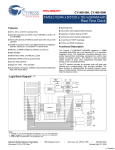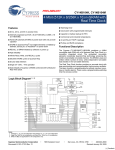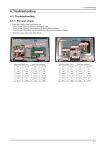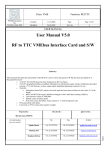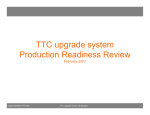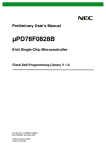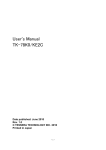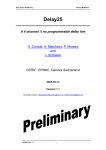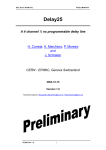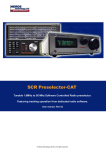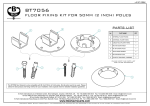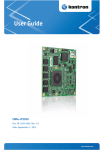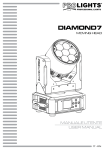Download User Manual
Transcript
Class: VME PH/ESS document No: PH-ESS-29-01-2007 Function: RF to TTC Created : 11.10.2006 Modified: 29.01.2007 Page Rev.No. Page 1 of 25 1 USER MANUAL RF2TTC 1.0 RF to TTC VMEbus Interface Card and S/W Summary: This document describes the functionality of the RF2TTC card as well as the generic S/W that has been developed for it. Prepared by : Checked by : Approved by : Sophie Baron, PH/ESS Markus Joos, PH/ESS Tel. Fax. E-Mail Sophie Baron +41.22.7677339 +41.22.7678925 [email protected] Markus Joos +41.22.7672364 +41.22.7678925 [email protected] for information, you can contact : PH/ESS Document. No. PH – ESS – 29 – 01 – 2007 Page Rev. No. 2 of 25 1 Table of Contents 1. Introduction.............................................................................................................................................3 2. RF2TTC Hardware .................................................................................................................................5 2.1. VMEbus interface............................................................................................................................................. 5 2.2. VME64x CR/CSR space................................................................................................................................... 5 2.2.1. 2.2.2. CSR Space .................................................................................................................................................................. 6 CR Space..................................................................................................................................................................... 7 2.3. Control and status registers............................................................................................................................. 8 2.4. Calibration procedures .................................................................................................................................. 22 2.5. Board configuration ....................................................................................................................................... 22 2.6. Fibre / cable connections................................................................................................................................ 23 2.7. Front-panel LEDs........................................................................................................................................... 24 2.8. Improvements for the version 3 .................................................................................................................... 24 2.8.1. 2.8.2. 3. Initialisation procedure ............................................................................................................................................. 24 others......................................................................................................................................................................... 24 RF2TTC common software ..................................................................................................................25 3.1. Introduction .................................................................................................................................................... 25 3.1.1. 3.1.2. H/W Environment..................................................................................................................................................... 25 S/W Environment...................................................................................................................................................... 25 3.2. Test programs ................................................................................................................................................. 25 3.3. The user library .............................................................................................................................................. 25 PH/ESS Document. No. PH – ESS – 29 – 01 – 2007 Page Rev. No. 3 of 25 1 1. INTRODUCTION The RF2TTC (RF to TTC VMEbus Interface Card) is an interface card between the optical receiver modules (receiving timing signals coming from the SR4 building in Echenevex), and the TTC electronics within the experiments. FINE DELAYS CONTROL REMOTE CONTROL I2C The timing signals treated by the RF2TTC are the three 40.078MHz Bunch Clocks (BC1, BC2 and BCref) and the two orbit signals (Orb1 and Orb2) necessary to drive the 2 beam lines of the LHC. The RF2TTC module converts them into ECL signals, and performs various adjustments on each signal before making them available for the in-detector TTC electronics. RF2TTC module diagram The three Bunch Clocks (represented on the top part of the above diagram) are all treated in the following way: A comparator with an adjustable threshold first converts the input signal into a PECL signal, before being multiplexed with an internal 40.078MHz clock in case of absence of the Bunch Clock on the front panel. The signal is then shifted by an adjustable delay with 0.5ns precision, before being cleaned by a QPLL and transmitted on the front panel via an ECL 50 Ohm coaxial cable driver with an AC-coupled output. PH/ESS Document. No. PH – ESS – 29 – 01 – 2007 Page Rev. No. 4 of 25 1 A global multiplexer allows selection between the three Bunch Clocks and the internal clock to generate a fourth Bunch Clock output, called Main BC, which can also be delayed. The two orbit signals (middle and bottom right parts of the diagram) are first converted using the same adjustable comparator stage as for the Bunch Clocks. They are then lengthened to more than 25ns, finely delayed with 0.5ns steps, before going into an FPGA (grey block of the diagram), where they are synchronized to their corresponding clock, multiplexed with an internal orbit, and coarse delayed. Their length and polarity can be adjusted, and they are then again finely delayed before being transmitted by the ECL drivers. A global multiplexer also allows selection between the two orbits and an internal one, synchronized to the Main Bunch Clock. This orbit signal is called Main Orbit and can as well be finely delayed before being transmitted. The BST (Beam Synchronous Timing) optical signal (on the bottom left part of the diagram) is received, decoded and analyzed to recover the machine mode. This mode is useful to know when the timing signals are stable and can be used. In deed, neither the Bunch Clocks nor the Orbit signals are fully guaranteed out of the physics modes (flat top of the LHC energy curve). It is thus advised to use internal signals when the machine mode indicates that there is no beam. All the adjustments are done using VME registers. Many status registers are available, as well as special configurations, for standalone or debugging work. This document contains a description of all accessible registers of the RF2TTC card as well as description of the generic S/W that has been developed for this card. At the end of this document, some basic examples of configuration procedures are proposed. PH/ESS Document. No. Page PH – ESS – 29 – 01 – 2007 5 of 25 Rev. No. 1 2. RF2TTC HARDWARE 2.1. VMEBUS INTERFACE The VMEbus interface of the RF2TTC cards is implemented in its FPGA and based on the VME interface developed by Peter Lichard for the TRT-TTC board (ATLAS). It provides three types of VMEbus addressable resources as described in Table 1. Resource VMEbus access mode Description Geographical or Manual addressing The RF2TTC provides a limited set of (A24/D32 with AM-code = 0x2F) CR/CSR registers. Control and status registers A32/D32 with A19=0 and AM-code These are the registers that control the 0x09 behaviour of a RF2TTC card and provide information about its current status. EPROM A32/D32 with A19=1 and AM-code The access to the EPROM is reserved for in0x09 crate reconfiguration. Table 1: VMEbus resources of the RF2TTC 2.2. VME64X CR/CSR SPACE This space is accessible using A24, D32, 0x2F AM code. The BAR is loaded at sysreset with the value set by the rotary switch if it is different from 0x00, and with the geographical address if the manual address=0x00. So, until the BAR value is not changed, the board address is the geographical address of the module if the manual rotary switches are set to 0x00. If the BAR is changed, the board address is the content of the BAR(see below).The address used to access the CR/CRS space is hence defined as follows: BAR content value: BAR[7..4] SW(7..0)=0x00 SW(7..0)≠0x00 SW1 BAR[3] GEOG ADD Comments After a sysreset SW1[0], SW2[4..1] SW2[0] After a sysreset VmeData[7..4] VmeData[3] If BAR is written via a VME access with 0x2F AM SW2 CR/CSR space address: A23-A20 BAR[7..4] A19 A18-A1 BAR[3] Register offset in the CR/CSR space PH/ESS Document. No. PH – ESS – 29 – 01 – 2007 2.2.1. Page 6 of 25 Rev. No. 1 CSR Space The registers available on CR/CSR space are some of the registers defined on the VME64 specification. You can find them in the following table: Register Offset Purpose Access BAR[7..0] 0x7FFFC Base address VME CSR BSET 0x7FFF8 Set board reset VME CSR BCLR 0x7FFF4 Clear board reset VME CSR UBSET 0x7FFEC Set user reset VME CSR UBCLR 0x7FFE8 Clear user reset VME CSR ADER_F7 0x7FFD0 Function 7 VME CSR ADER_F6 0x7FFC0 Function 6 VME CSR ADER_F5 0x7FFB0 Function 5 VME CSR ADER_F4 0x7FFA0 Function 4 VME CSR UBSET (User-defined BSET) Register assignment Description: This register is declared in the VME64x as a User-defined Bset register. It is used here to define partial reset functions (QPLL only, Delay25 chips only, TTCrx only). The bit definition is as follows: Bit Value 0 1 2 Write Read 1 place Delay25 chips in reset mode Delay25 chips in reset mode 0 no effect Delay25 chips not in reset mode 1 place QPLL chips in reset mode QPLL chips in reset mode 0 no effect QPLL chips not in reset mode 1 place TTCrx chips in reset mode TTCrx chips in reset mode 0 no effect TTCrx chips not in reset mode PH/ESS Document. No. PH – ESS – 29 – 01 – 2007 Page 7 of 25 Rev. No. 1 UBCLEAR (User-defined BCLEAR) Register assignment Description: This register is declared in the VME64x as a User-defined Bclear register. It is used here to remove partial reset functions (QPLL only, Delay25 chips only, TTCrx only). The bit definition is as follows: Bit Value 0 1 2 2.2.2. Write Read 1 remove Delay25 chips from reset mode Delay25 chips in reset mode 0 no effect Delay25 chips not in reset mode 1 remove QPLL chips from reset mode QPLL chips in reset mode 0 no effect QPLL chips not in reset mode 1 remove TTCrx chips from reset mode TTCrx chips in reset mode 0 no effect TTCrx chips not in reset mode CR Space Register Address Value Access MANUFACTURER ID 0x00024 0x00080030 R BOARD ID 0x00030 0x0000016B R REVISION ID 0x00040 Hardware version R Prototype = 0x2 PROGRAM ID 0x00074 Firmware date number Ex: 0x28112006 (28 of November 2006) R PH/ESS Document. No. Page PH – ESS – 29 – 01 – 2007 2.3. Rev. No. 8 of 25 1 CONTROL AND STATUS REGISTERS This space is accessible using 0x09 AM (A32, D32). The board address is the geographical address of the module if the manual rotary switches are set to 0x00.The address used to access the user space is hence defined as follows: A31-A28 SW1 SW(7..0)=0x00 SW2 SW(7..0)≠0x00 A27-A24 0 0 A23-A20 GEOG ADD SW1[7..5] A19-A16 0x7 SW2[4..0] BCx_MAN_SELECT, BCx_BEAM_SELECT & BCx_NOBEAM_SELECT Name Offset Size Access BC1_MAN_SELECT 0xFBFC 1 bit R/W BC2_MAN_SELECT 0xFBCC BCref_MAN_SELECT 0xFBAC BC1_BEAM_SELECT 0xFBF8 BC2_BEAM_SELECT 0xFBC8 BCref_BEAM_SELECT 0xFBA8 BC1_NOBEAM_SELECT 0xFBF4 BC2_NOBEAM_SELECT 0xFBC4 BCref_NOBEAM_SELECT 0xFBA4 BCmain_MAN_SELECT 0xFB8C BCmain_BEAM_SELECT 0xFB88 BCmain_NOBEAM_SELECT 0xFB84 2 bits Description: These registers select the sources of the BC outputs. Only one set of registers is active at any time. The BCx_MAN_SELECT registers are active when the RF2TTC is operating in manual mode. If the card is in automatic mode and the beam is on the BC outputs are controlled by the BCx_BEAM_SELECT registers. The BCx_NOBEAM_SELECT registers control the BC outputs when the RF2TTC is in automatic mode and the beam absent. Bit definition for BC1, BC2 and BCref registers Value Description 0 Output taken from internal 40.078MHz clock 1 Output follows the respective BC input Bit definition for BCmain registers PH/ESS Document. No. PH – ESS – 29 – 01 – 2007 Value Page Rev. No. 9 of 25 1 Description 0 Output taken from internal 40.078MHz clock 1 Output follows BCref input 2 Output follows BC2 input 3 Output follows BC1 input BCx_QPLL_MODE Name Offset Size Access BC1_QPLL_MODE 0xFBF0 1 bit R/W BC2_QPLL_MODE 0xFBC0 BCref_QPLL_MODE 0xFBA0 BCmain_QPLL_MODE 0xFB80 Description: These registers define the QPLL locking mode. Value Description 0 Re-lock only after a reset 1 Re-lock automatically if the lock gets lost BCx_DAC Name Offset Size Access BC1_DAC 0xFBEC 8 bits R/W BC2_DAC 0xFBBC BCref_DAC 0xFB9C Description: These registers define the threshold of the input comparator for the respective BC input channel in a range from -1.25V to +1.25V. The threshold is linked to the value of the register by the formula Threshold = -1.25 + value * 2.5 / 255 BCx_QPLL_STATUS Name Offset Size Access BC1_QPLL_STATUS 0xFBE8 2 bits R BC2_QPLL_STATUS 0xFBB8 BCref_QPLL_STATUS 0xFB98 BCmain_QPLL_STATUS 0xFB7C PH/ESS Document. No. PH – ESS – 29 – 01 – 2007 Page Rev. No. 10 of 25 1 Description: These registers contain the status of the QPLLs of the BC channels. Bit 1 indicates that the QPLL detected an error and bit 0 indicates the locking status. Bit 1 Description 0 QPLL OK 1 QPLL has error Bit 0 Description 0 QPLL not locked 1 QPLL locked ORBx_MAN_SELECT, ORBx_BEAM_SELECT & ORBx_NOBEAM_SELECT Name Offset Size Access ORB1_MAN_SELECT 0xFB6C 1 bit R/W ORB2_MAN_SELECT 0xFB2C ORB1_BEAM_SELECT 0xFB68 ORB2_BEAM_SELECT 0xFB28 ORB1_NOBEAM_SELECT 0xFB64 ORB2_NOBEAM_SELECT 0xFB24 ORBmain_MAN_SELECT 0xFAEC ORBmain_BEAM_SELECT 0xFAE8 ORBmain_NOBEAM_SELECT 0xFAE4 2 bits Description: These registers select the sources of the orbit outputs. Only one set of registers is active at any time. The ORBx_MAN_SELECT registers are active when the RF2TTC is operating in manual mode. If the card is in automatic mode and the beam is on the orbit outputs are controlled by the ORBx_BEAM_SELECT registers. The ORBx_NOBEAM_SELECT registers control the orbit outputs when the RF2TTC is in automatic mode and the beam absent. Bit definition for ORB1 and ORB2 registers Value Description 0 Output follows the respective orbit input 1 Output from internal BC synchronized orbit generator Bit definition for ORBmain registers Value Description PH/ESS Document. No. PH – ESS – 29 – 01 – 2007 0 Output follows the orbit 1 input 1 Output follows the orbit 2 input 2 Output from internal BCmain synchronized orbit generator Page Rev. No. 11 of 25 1 ORBx_POLARITY Name Offset Size Access ORB1_POLARITY 0xFB60 1 bit R/W ORB2_POLARITY 0xFB20 ORBmain_POLARITY 0xFAE0 Description: If set, this bit inverts the polarity of the orbit output with respect to the orbit input (i.e. the orbit output is negative active). ORBx_COARSE_DELAY Name Offset Size Access ORB1_COARSE_DELAY 0xFB5C 12 bits R/W ORB2_COARSE_DELAY 0xFB1C ORBmain_COARSE_DELAY 0xFADC Description: This register allows the orbit output signal to be shifted by multiples of 25 ns with respect to the input. If set to 0, the output is shifted by the minimum intrinsic delay induced by the board itself. Values above 0xDEB (3563) are illegal because they would result in a shift longer than the LHC orbit period (88.93 µs) ORBx_LENGTH Name Offset Size Access ORB1_LENGTH 0xFB58 8 bits R/W ORB2_LENGTH 0xFB18 ORBmain_LENGTH 0xFAD8 Description: This register allows the orbit pulse to be stretched in steps of 25 ns. If set to 0 the width of the orbit pulse is stretched by 75 ns. The largest pulse width (with all 8 bits set to 1) is 6.4 µs. The original width of the internally generated orbit pulse is 75ns. ORBx_INT_PERIOD_SET Name Offset Size Access PH/ESS Document. No. Page PH – ESS – 29 – 01 – 2007 ORB1_INT_PERIOD_SET 0xFB54 ORB2_INT_PERIOD_SET 0xFB14 ORBmain_INT_PERIOD_SET 0xFAD4 12 bits 12 of 25 Rev. No. 1 R/W Description: This register allows setting the period of the internally generated orbit signal in units of 25 ns. The default value is 0xDEB, which corresponds to 3563 bunch clocks between two orbits. ORBx_INT_PERIOD_COUNTER Name Offset Size Access ORB1_INT_PERIOD_COUNTER 0xFB50 12 bits R ORB2_INT_PERIOD_COUNTER 0xFB10 ORBmain_INT_PERIOD_COUNTER 0xFAD0 Description: This register is provided for debugging purposes. It holds the value of the BC counter that is used to generate the internal orbit signal. This can be reset by the ORB_INT_RESET register. PH/ESS Document. No. Page PH – ESS – 29 – 01 – 2007 13 of 25 Rev. No. 1 ORBx_COUNTER Name Offset Size Access ORB1_COUNTER 0xFB4C 32 bits R ORB2_COUNTER 0xFB0C ORBmain_COUNTER 0xFACC Description: This register holds the number of orbit pulses that have been received since the counter was reset/enabled. At an orbit period of 89 µs this counter will overflow after approximately 106 hours, and will be reset. ORBx_PERIOD_RD Name Offset Size Access ORB1_PERIOD_RD 0xFB48 12 bits R ORB2_PERIOD_RD 0xFB08 ORBmain_PERIOD_RD 0xFAC8 Description: This register holds the time, in units of 25 ns BC ticks, that has elapsed between the last two orbit output pulses. ORBx_PERIOD_FIFO_STATUS Name Offset Size Access ORB1_PERIOD_FIFO_STATUS 0xFB44 2 bits R ORB2_PERIOD_FIFO_STATUS 0xFB04 ORBmain_PERIOD_FIFO_STATUS 0xFAC4 Description: This register holds the status of the FIFO that contains the most recent 128 orbit periods of the respective orbit output channel. Bit definitions: Bit Value 0 1 Description 0 Fifo not empty 1 Fifo empty 0 Fifo not full 1 Fifo full PH/ESS Document. No. Page PH – ESS – 29 – 01 – 2007 14 of 25 Rev. No. 1 ORBx_PERIOD_FIFO_RD Name Offset Size Access ORB1_PERIOD_FIFO_RD 0xFB40 16 bits R ORB2_PERIOD_FIFO_RD 0xFB00 ORBmain_PERIOD_FIFO_RD 0xFAC0 Description: These registers provide access to three 256 word deep FIFOs which contain the most recent 256 orbit periods of the respective orbit output channel in bits 0..13. Reading the last period stored in the FIFO, or from an empty FIFO results in reading a 1 in bit 14 (FIFO empty) . Bit 15, if set to 1, indicates that the FIFO is full. For the moment it is not possible to read these FIFOs with a constant address block transfer. ORBx_DAQ Name Offset Size Access ORB1_DAQ 0xFB3C 8 bits R/W ORB2_DAQ 0xFAFC Description: These registers allow setting the threshold voltage of the orbit input comparator in a range from 1.25 V to +1.25 V. The threshold is linked to the value of the register by the formula: Threshold = -1.25 + value * 2.5 / 255 TTCrx_status Name Offset Size Access TTCrx_status 0xFAA0 1 bit R Description: This register reflects the status of the on-board TTCrx chip. Bit definitions: Description Value 0 TTCrx not ready 1 TTCrx ready – the BST message is correctly decoded (at least a 40MHz clock is sent over the optical fibre connected to the TTCrx) BST_Machine_Mode Name Offset Size Access BST_Machine_Mode 0xFA9C 32 bits R PH/ESS Document. No. Page PH – ESS – 29 – 01 – 2007 15 of 25 Rev. No. 1 Description: This register holds the LHC machine mode as decoded from the BST messages received by the TTCrx.. Each number (here in hexadecimal) corresponds to one machine mode, as transmitted by the BST: Value Description 0 No Beam 1 Filling 2 Ramping 3 Physics 4 5 6 7 8 BEAM_NO_BEAM_DEF Name Offset Size Access BEAM_NO_BEAM_DEF 0xFA7C 32 bits R/W Description: This register controls the operation of the RF2TTC in automatic mode. Each bit controls one machine mode. A bit that is set to 0 causes the RF2TTC to use the NOBEAM_SELECT registers for BC and orbit to be active when the machine is in the mode that corresponds to that bit. If a bit is set to 1 the RF2TTC applies the settings in the BC and orbit BEAM_SELECT registers for as long as the machine is in the respective mode. Bit MODE Name Description Default 0 No Beam 0= NOBEAM mode, 0 1 Filling 0 2 Ramping 1= BEAMMODE when automatic mode is activated. 3 Physics 4 5 6 0 1 PH/ESS Document. No. Page PH – ESS – 29 – 01 – 2007 16 of 25 Rev. No. 1 WORKING_MODE Name Offset Size Access WORKING_MODE 0x7FA78 7 bits R/W Description: The bits in this register control the operational modes of the outputs of the RF2TTC. Each bit corresponds to one signal. Bit number Related output 0 BC1 1 Bit value BC2 2 BCref 3 BCmain 4 ORB1 5 ORB2 6 ORBmain Selected mode 0 Manual 1 Automatic 0 Manual 1 Automatic 0 Manual 1 Automatic 0 Manual 1 Automatic 0 Manual 1 Automatic 0 Manual 1 Automatic 0 Manual 1 Automatic ORB_INT_ENABLE Name Offset Size Access ORB_INT_ENABLE 0xFA6C 3 bits R/W Description: This register controls the status of the BC counters that generate the internal orbit pulses. Bit number Related orbit 0 Orbit 1 (counts BC1 ticks) 1 2 Orbit 2 (counts BC2 ticks) Main orbit (counts BCmain ticks) Bit value Counter mode 0 Disabled 1 Enabled 0 Disabled 1 Enabled 0 Disabled 1 Enabled PH/ESS Document. No. Page PH – ESS – 29 – 01 – 2007 17 of 25 Rev. No. 1 ORB_COUNTER_ENABLE Name Offset Size Access ORB_COUNTER_ENABLE 0xFA68 3 bits R/W Description: This register controls the status of the orbit pulse counters. Once a channel has been enabled the registers ORBx_COUNTER count the orbit pulses of that channel Bit number Related orbit 0 Orbit 1 1 2 Bit value Orbit 2 Main orbit Counter mode 0 Disabled 1 Enabled 0 Disabled 1 Enabled 0 Disabled 1 Enabled PERIOD_COUNTER_ENABLE Name Offset Size Access PERIOD_COUNTER_ENABLE 0xFA64 3 bits R/W Description: This register controls the status of the orbit period counters. Once a channel has been enabled the FIFOs and ORBx_PERIOD_FIFO_RD start measuring and storing the duration of orbit signals. Bit number Related orbit 0 Orbit 1 1 2 Orbit 2 Main orbit Bit value Counter mode 0 Disabled 1 Enabled 0 Disabled 1 Enabled 0 Disabled 1 Enabled PH/ESS Document. No. Page PH – ESS – 29 – 01 – 2007 Rev. No. 18 of 25 1 RESET registers Name Offset Access Function ORB_INT_RESET 0xFA4C W Reset the three counters that generate the internal orbits 1, 2 and Main. One bit per counter. Same definition than the ORB_INT_ENABLE register. PERIOD_COUNTER_RE SET 0xFA48 Reset the counters that measure the period of the orbit pulses 1, 2 and Main. At the same time the period FIFOs are cleared. One bit per counter. Same definition than the PERIOD_COUNTER_ENABLE register. ORB_COUNTER_RESET 0xFA44 Reset the orbit pulse counters 1, 2 and Main Description: A reset is triggered by writing a 1 to the address of the respective register. The 3 bits of the counter_reset register can reset the counters of ORB1, ORB2 and/or ORBmain, by writing various patterns: Bit number Related orbit 0 Orbit 1 1 2 Orbit 2 Main orbit Bit value Counter mode 0 No effect 1 reset 0 No effect 1 reset 0 No effect 1 reset PH/ESS Document. No. Page PH – ESS – 29 – 01 – 2007 19 of 25 Rev. No. 1 DELAY25_REG, TTCrx_REG Name Offset Size Access DELAY25_REG 0xD200 8 bits R TTCrx_REG 0xE200 Description: These registers are required to read values from the TTC and Delay25 registers described below. Due to delays introduced by the I2C bus it is not possible to read these registers directly. Instead a sequence of three steps is required. 1) Read a dummy data word from the address of the TTC or Delay25 register that is to be read out 2) Wait for at least 2 ms 3) Read the data value from the DELAY25_REG or TTCrx_REG (FIFO contents of the read access to delay25 and TTCrx chips) If multiple registers are to be read one can group the dummy reads (step 1) and data reads (step 3) such that they are only separated by one 2 ms delay. This pipelining however works for up to 256 read requests. BC_ DELAY25_x Name Offset Used Size Access BC_DELAY25_GCR 0xD014 Yes 8 bits (R)/W BC_DELAY25_BCmain 0xD00c Yes BC_DELAY25_BCref 0xD008 Yes BC_DELAY25_BC2 0xD004 Yes BC_DELAY25_BC1 0xD000 Yes Description: These registers control the configuration of the Delay25 chips for the BC signals. These chips ensure the BC signal to be shifted by steps of 0.5ns with a jitter lower than 19ps rms. For details about the read protocol see above. Bit definition (from Delay25 manual): The bit allocation of each channel control register is as given in the following table. Bits Del<5:0> control the delay for each channel and the Enable bit enables the channel output. Upon a reset, bit Enable and bits Del<5:0> are cleared. Control registers (CR0 to CR4) bit allocation B7 n.u . n.u . B6 Enable B5 Del<5> Del<4> B4 Del<3> B3 Del<2> B2 Del<1> B1 Del<0> B0 Function 0 0 0 0 0 0 0 Reset State The general control register GCR controls the operation of the Delay-Locked Loop (DLL) and allows to reset the DLL or the ASIC via the I2C interface. The bit allocation for this register is given in Table 4 PH/ESS Document. No. Page PH – ESS – 29 – 01 – 2007 20 of 25 Rev. No. 1 General Control Register (GCR) bit allocation B7 reserve d 0 B6 IDL L 0 B5 n.u . - B4 B3 n. n.u n.u u . . - B2 M<1> B1 M<0> B0 Function Not cleared Not cleared Reset State The ASIC can operate with for different clock frequencies (32, 40, 64 and 80 MHz). For this application, the M<0> and M<1> bits must be set to 0 (40MHz). IDLL: bit IDLL is used to force the resynchronization of the DLL without resetting the chip. Writing a “1” to this bit forces the resynchronization of the DLL. This bit always reads as a “0” ORBIN_DELAY25_x Name Offset Used Size Access ORBIN_DELAY25_GCR 0xD034 yes 8 bits (R)/W ORBIN_DELAY25_ORB2 0xD024 Yes ORBIN_DELAY25_ORB1 0xD020 Yes Description: These registers control the configuration of the Delay25 chips for the orbit input signals. Finely adjusting the delay of the orbit inputs allows centralising the orbit pulse with the rising edge of the corresponding bunch clock to ensure a good synchronisation of the 2 signals. For details about the read protocol see above. Bit definition: see BC_DELAY_x register. ORBOUT_DELAY25_x Name Offset Used Size Access ORBOUT_DELAY25_GCR 0xD054 Yes 8 bits (R)/W ORBOUT_DELAY25_ORBmain 0xD048 Yes ORBOUT_DELAY25_ORB2 0xD044 Yes ORBOUT_DELAY25_ORB1 0xD040 Yes Description: These registers control the configuration of the Delay25 chips for the orbit output signals. This adjustment is to allow the experiments fine tuning the orbit for its use in their trigger electronics. For details about the read protocol see above. Bit definition: see BC_DELAY_x register. TTCrx registers Name Offset Size Access TTCrx_pointer to the register 0xE000 8 bits R/W TTCrx_pointer to the data 0xE004 8 bits W PH/ESS Document. No. PH – ESS – 29 – 01 – 2007 Page Rev. No. 21 of 25 1 Description: These are the two registers used to read and write all the internal registers of the TTCrx used to receive the BST message (see TTCrx user manual). Only one register requires to be accessed for the purpose of receiving the BST message: the control register (internal address= 0x03). Its value should be 0xB3 instead of 0x93 (its default value). The ‘1’ added on bit 5 allows enabling the Dout bus of the TTCrx, which contains the broadcast data, and hence the Machine Mode. Register access protocol: The TTCrx chip needs to be ready (ie, the optical fibre needs to deliver a correct encoded 40MHz clock), in order to access the internal registers. The way to access the TTCrx registers is described in the TTCrx manual, p30: “I2C_pointer register and the I2C_data register. The I2C_pointer register is five bits wide and contains the address of the internal register as defined in Table 3 (page 16). When reading the I2C_data register, the content of the TTCrx register being addressed by the pointer register is transferred. Conversely, writing a byte to the I2C_data register in fact writes to the TTCrx register addressed by the I2C_pointer register. Hence, each I2C access is performed in two steps: 1) Write the register number in the I2C_pointer register 2) Read or write the I2C_data register According to the I2C bus specification, each device on the bus is addressed by a 7-bit wide I2C device address. Each TTCrx chip occupies two consecutive positions in the 7-bit I2C address space. Hence, it is possible to address 64 devices in the system. The 7-bit I2C address is derived from the content of the ID_I2C<5:0> base address register in the following way: I2C access register name I2C_pointer Resulting 7 bit I2C address ID_I2C<5:0> * 2 I2C_data ID_I2C<5:0> * 2 + 1 Table 12 I2C address calculation.” The registers accessible via I2C are the following: I2C reg. address (decimal) 0 1 2 3 8 9 10 11 16 17 18 19 20 21 22 24 25 26 27 28 Register name Fine Delay 1 Fine Delay 2 Coarse Delay Control Single error count<7:0> Single error count<15:8> Double error count<7:0> SEU error count <15:8> ID<7:0> MasterModeA<1:0>, ID<13:8> MasterModeB<1:0>, I2C_ID <5:0> Config 1 Config 2 Config 3 Status Bits <7:0> Bits <15:8> Bits <7:0> Bits <15:8> Bits <23:16> Default content (After reset) 00000000 00000000 00000000 10010011 00000000 00000000 00000000 00000000 00000000 00000000 00000000 00011010 10000100 10100111 11100000 00000000 00000000 00000000 00000000 00000000 PH/ESS Document. No. Page PH – ESS – 29 – 01 – 2007 22 of 25 Rev. No. 1 Example of registers read and write via VME access: Read control register (I2C address 3): 1- VME WRITE, AM=0x09, RegOFFSET=0xE000, Data=0x3 (register I2C address) 2- VME READ, AM=0x09, RegOFFSET=0xE000, (the Data read has no meaning) 3- VME READ, AM=0x09, RegOFFSET=0xE200, Data should be 0x00000003 Write Fine Delay Register (I2C address 1): 1- VME WRITE, AM=0x09, RegOFFSET=0xE000, Data=0x1 (register I2C address) 2- VME WRITE, AM=0x09, 0x0000YOURDATA RegOFFSET=0xE004 (offset of the data register), Read fine delay register (I2C address 1): 1- VME WRITE, AM=0x09, RegOFFSET=0xE000, Data=0x1 2- VME READ, AM=0x09, RegOFFSET=0xE000, (the Data read has no meaning) 3- VME READ, AM=0x09, RegOFFSET=0xE200, Data should be 0x000XYOURDATA, with X=0 if the fIFO is not empty, X=1 if you are reading the last word stored in a FIFO Successively read fine delay registers 1 and 2 (I2C address 1 and 2): 4- VME WRITE, AM=0x09, RegOFFSET=0xE000, Data=0x1 5- VME READ, AM=0x09, RegOFFSET=0xE000, (the Data read has no meaning) 6- VME WRITE, AM=0x09, RegOFFSET=0xE000, Data=0x2 7- VME READ, AM=0x09, RegOFFSET=0xE000, (the Data read has no meaning) 8- VME READ, AM=0x09, RegOFFSET=0xE200, Data should be 0x0000YOURDATA 9- VME READ, AM=0x09, RegOFFSET=0xE200, Data should be 0x0001YOURDATA 2.4. CALIBRATION PROCEDURES For a proper functioning of the RF2TTC in its environment a number of coarse and fine grained pulse delay and stretch registers have to be tuned by the user. A description of this procedure will follow once if that been analyzed to what extent the RF2TTC can perform FPGA-based autocalibrations. 2.5. BOARD CONFIGURATION Element Description LSB rotary switch TBD MSB rotary switch TBD PH/ESS Document. No. PH – ESS – 29 – 01 – 2007 2.6. Page 23 of 25 Rev. No. 1 FIBRE / CABLE CONNECTIONS Connector name To be connected to BST TTC encoded signal. One of the BST optical fibres (two are normally available, one per ring). The optical power level should be between -5dBm and -25dBm. BC INPUTS – BC1 ECL AC coupled signal. Should be connected to the BC1 output of the RF_Rx_D BC INPUTS – BC2 ECL AC coupled signal. Should be connected to the BC2 output of the RF_Rx_D BC INPUTS – BC_REF ECL AC coupled signal. Should be connected to the BCref output of the RF_Rx_D ORB INPUTS – ORB1 ECL AC coupled signal. Should be connected to the ORB1 output of the RF_Rx_D ORB INPUTS – ORB2 ECL AC coupled signal. Should be connected to the ORB2 output of the RF_Rx_D BC OUTPUTS – BC1 ECL AC coupled signal. Experiments electronics. BC OUTPUTS – BC2 ECL AC coupled signal. Experiments electronics. BC OUTPUTS – BC_REF ECL AC coupled signal. Experiments electronics. BC OUTPUTS – BCmain ECL AC coupled signal. Experiments electronics. ORB OUTPUTS – ORB1 ECL AC coupled signal. Experiments electronics. ORB OUTPUTS – ORB2 ECL AC coupled signal. Experiments electronics. ORB OUTPUTS – ORBmain ECL AC coupled signal. Experiments electronics. PH/ESS Document. No. PH – ESS – 29 – 01 – 2007 2.7. Page Rev. No. 24 of 25 1 2.8. FRONT-PANEL LEDS LED Description BC1_LOCK Displays the state of the QPLL chip connected to the selected BC1 signal. (ON=locked/OFF=not locked). BC2_LOCK Displays the state of the QPLL chip connected to the selected BC1 signal. (ON=locked/OFF=not locked). BCREF_LOCK Displays the state of the QPLL chip connected to the selected BC1 signal. (ON=locked/OFF=not locked). BCmain_LOCK Displays the state of the QPLL chip connected to the selected BC1 signal. (ON=locked/OFF=not locked). ORB1_OK Monitors the presence of the external orbit after the comparator. (ON=signal present, OFF= no signal). When OFF, it can mean, either that the orbit is not present, or that the DAC setting the threshold at the input does not deliver an adapted threshold. ORB2_OK Monitors the presence of the external orbit after the comparator. (ON=signal present, OFF= no signal). When OFF, it can mean, either that the orbit is not present, or that the DAC setting the threshold at the input does not deliver an adapted threshold. BEAM Monitors if the current machine mode corresponds to a “BEAM” mode or a “NO BEAM” mode. (ON=BEAM/OFF=NO BEAM). BST ready Monitors the state of the TTCrx in charge of receiving and transmitting the BST message to the FPGA. (ON=TTCrx ready, received frame is consistent and can be decoded/ OFF=no consistent BST message). BERR Flashes when the RF2TTC generates a BERR. Not implemented yet. VME Flashes if the RF2TTC has replied to a VMEbus cycle IMPROVEMENTS FOR THE VERSION 3 2.8.1. Initialisation procedure The state of the Delay25 chips after a reset is not satisfactory, as the outputs are all disabled. The same for the TTCrx, which does not allow by default the transmission of the broadcast words. Finally, the DAC in charge of the threshold adjustments are set to -1.25V by default after power-up. Hence, the Delay25, TTCrx and DAC chips need to be initialised first, and it requires using some internal protocols (I2C or other), controlled by VME accesses. A solution will be provided to ensure the board initialisation without using a crate processor. This initialisation will ensure that: 2.8.2. • All the delay25 chips are enabled (i.e. transmit the signals present at their inputs) • All the DACs are configured correctly to allow latching the input signals if any • The TTCrx chips is configured to transmit the BST message to the FPGA others PH/ESS Document. No. PH – ESS – 29 – 01 – 2007 Page Rev. No. 25 of 25 1 3. RF2TTC COMMON SOFTWARE 3.1. INTRODUCTION Even though the RF2TTC performs the same task in each of the four LHC experiments it will be operated in H/W and S/W environments that are specific to the respective experiment. Therefore the common S/W is limited to the lowest level which consists of some diagnostic programs and a user library. This S/W is implemented in the rf2ttc package and can be found in CERN CVS repository at http://isscvs.cern.ch/cgi-bin/viewcvs-all.cgi/rf2ttc/?cvsroot=rf2ttc. For direct access from Unix use (e.g.) “setenv CVSROOT :kserver:isscvs.cern.ch:/local/reps/rf2ttc” 3.1.1. H/W Environment In the ATLAS and ALICE experiments the RF2TTC is controlled by a VMEbus SBC from Concurrent Technologies (either a VP110 or a VP315). CMS uses a PCI-VMEbus link from CAEN and LHCb a USB-VMEbus link from the same manufacturer. In all four experiments the crate that houses the RF2TTC should be VME64X compatible as otherwise it is not possible use geographical addressing. 3.1.2. S/W Environment On the low end ATLAS and ALICE will use the vme_rcc driver developed by ATLAS to communicate with the RF2TTC. CMS and LHCb will use S/W packages provided by CAEN for the respective interface. The common S/W will be programmed in a way that it is compatible with any of these bus access packages. At the top end each experiment has to develop appropriate secondary libraries and applications to interface the RF2TTC to their respective control systems. The development of the interface to the DIP server is also up to the experiments. 3.2. TEST PROGRAMS Currently there exists one program that comes in three flavours: rf2ttcscope_atlice (for ATLAS and ALICE), rf2ttsscope_cms and rf2ttcscope_lhcb. This interactive application can be used to read, decode and write any register of the RF2TTC in a (hopefully) intuitive way. If a users feels that some functionality is lacking he is welcome to contact the developer (M. Joos). It is e.g. possible to extend rf2ttcscope by additional command line parameters such that certain tests can be executed from scripts. A tcltk graphical user interface (rf2ttc.tcl) is also available for test purpose. It has been written for SBCs from Concurrent Technologies (VP110 and VP315). 3.3. THE USER LIBRARY This library consists of a common source file that implements the access to the registers of the RF2TTC in a generic way and a number of files to implement glue layers to the VMEbus access libraries from ATLAS and CAEN respectively.

























